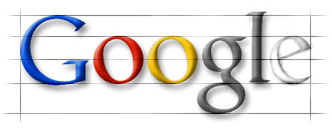Google logo creation history
 Ruth Kedar created the Google logo in the version that became famous and known to everyone in the world (originally, attempts were made to create a logo by one of the company's founders, Sergey Brin, according to rumors, using Gimp'a). I asked Ruth how the logo originally appeared and this is what she said. I taught design at Stanford University (Stanford University) in 1999 when our mutual friend from Stanford introduced me to Larry Page and Larry Brin. They were looking for a designer who would create a logo and website design for them, and I was asked to present some preliminary ideas. They liked my approach and design, in the end I was hired. Google wanted to create a unique logo that would distinguish it from other search engines at that time (Yahoo, Excite, HotBot, LookSmart and Lycos), and also embody their unique search vision These other search engines were primarily commercial portals and only then search engines. Google wanted to point out that this is primarily a search engine. He offered fast, comprehensive, and above all reliable search results. It was an innovative, algorithmically complex, but easy to use search engine. In addition, Google as a brand had to reject everything corporate, ordinary. On these principles many different versions of logos were created, differing in direction and style. With each new meeting, we took the best of all versions of the logo, which eventually led us to the final version of the design.
Ruth Kedar created the Google logo in the version that became famous and known to everyone in the world (originally, attempts were made to create a logo by one of the company's founders, Sergey Brin, according to rumors, using Gimp'a). I asked Ruth how the logo originally appeared and this is what she said. I taught design at Stanford University (Stanford University) in 1999 when our mutual friend from Stanford introduced me to Larry Page and Larry Brin. They were looking for a designer who would create a logo and website design for them, and I was asked to present some preliminary ideas. They liked my approach and design, in the end I was hired. Google wanted to create a unique logo that would distinguish it from other search engines at that time (Yahoo, Excite, HotBot, LookSmart and Lycos), and also embody their unique search vision These other search engines were primarily commercial portals and only then search engines. Google wanted to point out that this is primarily a search engine. He offered fast, comprehensive, and above all reliable search results. It was an innovative, algorithmically complex, but easy to use search engine. In addition, Google as a brand had to reject everything corporate, ordinary. On these principles many different versions of logos were created, differing in direction and style. With each new meeting, we took the best of all versions of the logo, which eventually led us to the final version of the design.  In the end, a well-known logo was chosen because it achieves a goal on many levels:
In the end, a well-known logo was chosen because it achieves a goal on many levels:- He is playful and deceptively simple. The logo is designed in such a way that it seems almost unprocessed and easy to read. The colors are reminiscent of a child's play, however, they are clearly different from the structure and rules of the color wheel. The textures and shadows of each letter are made in an unobtrusive manner that raises them above the page and at the same time gives a sense of volume. They are solid, but at the same time they have the effect of airiness.
- Times-Roman was the main font of the Internet at that time, and sans-serif fonts were widely used in print. I wanted the readability of the font and looked for one that would meet the requirements that we need - quite complex, but at the same time with humor and irregularity. The selected font was based on the Catull font, the old font from the serif-family. Catull borrows elements of traditional writing tools such as needles and chisels with a modern twist. Search is what requires us to look into the past. Therefore, the historical links of the Catull font seemed reasonable to us, since they created a kind of bridge between the old “analog” world and the new “digital” one.
- At that time, there were two points of view: either follow the neve giants, for example, Sun and SGI (all letters from the sans-serif family, uppercase and bold), or for Yahoo, whose raw logo was not very popular for the web. Google's design was supposed to break these points of view and lead to something new that Google wanted.

Today, Google is a much larger organization - it has changed and grown beyond our imagination - who knew that it would become one of the most popular and recognizable global brands and that the word google would become a noun and a verb? I am very pleased that the design has outlived the original goals that persecuted by the founders of Google and that today it is as popular as it was then. In addition, today the logo has become a canvas on which from time to time something blooms :)

The first logo with “grown flowers”: Burning Man Festival 1998
From me: The first versions of the site can be found at backrub.c63.be/index_old.htm

Logo description can be viewed at tarr.uspto.gov/servlet/tarr?regser=serial&entry=76314811
Sergey Brin's page at Stanford: infolab.stanford.edu/~sergey
this post on my blog
')
Source: https://habr.com/ru/post/31419/
All Articles